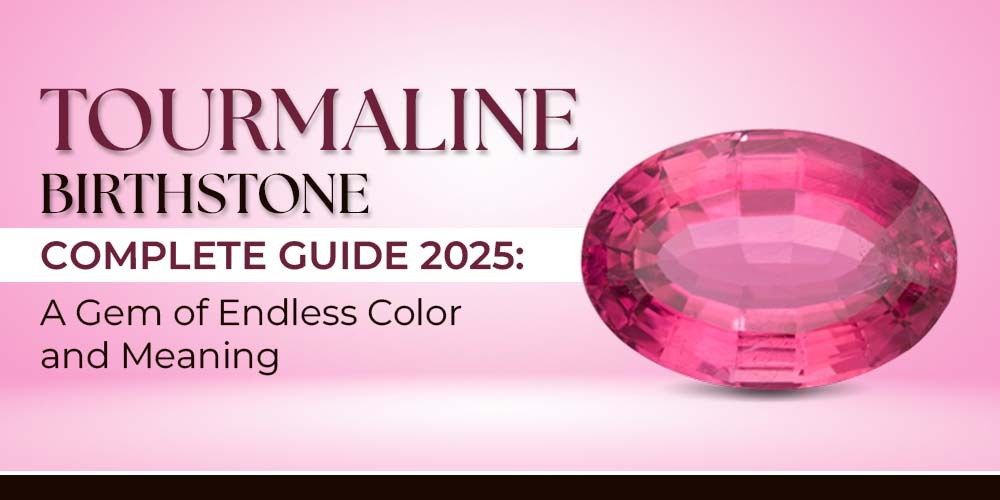If you were born in October, you are blessed with a gemstone that is among the most colorful and versatile in the mineral world, tourmaline. Officially a “modern” October birthstone (alongside opal), tourmaline is prized for its spectrum of hues, its emotional symbolism, and its ability to connect the wearer to both earth and spirit.
In this guide, we’ll journey from the geological roots to the practical decisions a buyer or admirer would make, all in a voice that respects both the gem professional and the passionate connoisseur.
1. A Gem of Many Colors: Identity & Science of Tourmaline
1.1 What Is Tourmaline?
Tourmaline is not a single mineral but a group of closely related silicate minerals. Its general chemical structure (a cyclosilicate) allows for many elemental substitutions, which is why tourmaline comes in such a stunning variety of colors.
-
Hardness: 7.0 – 7.5 on the Mohs scale, fairly durable for most everyday jewelry, though care is needed.
-
Optical properties: tourmaline often exhibits pleochroism (color change when viewed from different angles) because of its anisotropic internal structure.
-
Fracture/cleavage: indistinct cleavage and uneven to conchoidal fracture.
Because of these structural features, tourmaline is both complex and forgiving: it can present challenges (inclusions, directional color) but also rewards (beautiful color depth, unique phenomena).
1.2 The Origin of Its Name & Color Richness
The name “tourmaline” is derived from the Sinhalese (Sri Lankan) word toramalli, meaning “mixed stone / mixed colors”, a nod to its capacity to carry many hues, sometimes even within the same crystal.
In fact, tourmaline was long misidentified; red variants were confused with ruby, green with emerald, blue with other gems, until gemological methods improved in the 19th century.
Because its chemical lattice allows many substitutions (Mg, Fe, Li, Mn, Cu, etc.), trace elements cause the kaleidoscope of colors: from greens and blues to purples, reds, yellows, and multi-hued forms.
2. Color, Varieties & Phenomena
2.1 Signature Color Classes & Names
Here are some of the well-known varieties of tourmaline and their characteristic traits:
Even within these names, there can be gradations of tone and saturation that dramatically affect value. A pale or brownish version of a color is often far less valuable than a vivid, clean example.
2.2 Color Intensity, Saturation & Rarity
Color is often considered the king of value in tourmaline. Highly saturated, vivid colors without “dead zones” or black “dirt” tend to command premium prices. Some of the rarest and most prized are:
-
Paraíba / copper tourmaline: its neon hues are extremely desirable and expensive.
-
Deep, saturated rubellites (without brown overtones): red tones free of brown or orange drift tend to be more valuable.
-
Clean bi-color / watermelon slices: stones that elegantly separate their colors are collectible.
But remember: even less saturated “earthy” colors (olive greens, muted pinks) have become trendy and appreciated, especially when well cut.
2.3 Optical Effects & Inclusions
-
Pleochroism is common; the gem can display different colors from different viewing directions. That’s why how it’s cut matters.
-
Inclusions are also common: long, liquid, or “thread-like” inclusions running parallel to the crystal’s length are typical.
-
Some tourmalines may display a cat’s eye (chatoyancy) effect if fibrous inclusions are oriented.
Because of inclusions, clarity expectations for tourmaline differ from, say, those for diamond; more inclusions are tolerated if the stone remains visually appealing.
3. Legends, Symbolism & Modern Meaning
3.1 Historical & Cultural Lore
-
In ancient times, tourmaline was often mistaken for other gemstones (rubies, emeralds, sapphires) before its identity was clarified in the 19th century.
-
There’s a romantic legend: tourmaline, on its journey to the Earth’s surface, passed through a rainbow, picking up all its vibrant colors, hence its spectrum.
-
Some believe the famous “Cæsar’s Ruby” in the Russian crown jewels is actually rubellite (tourmaline).
3.2 Symbolism & Metaphysical Beliefs
These beliefs may not be scientifically verifiable, but they enrich the human experience of gemstones. Common associations include:
-
Balance, protection & grounding: tourmaline is often seen as a stone that helps stabilize inner energies.
-
Creativity & self-expression: because of its rainbow palette, many see it as a muse stone.
-
Healing of the heart & emotions: pink tourmaline is especially tied to love and compassion; green is tied to strength, regeneration.
-
Some also believe tourmaline can neutralize electromagnetic pollution or negative energy.
While you may or may not include these themes depending on the audience, they often resonate in personal storytelling.
4. Source Localities & Ethical Considerations
4.1 Major Producing Regions
Tourmaline is found across the globe. Some significant sources are:
-
Brazil (especially for many gem-quality tourmalines
-
Mozambique (a rising source, especially for bi-color and pinks)
-
Madagascar, Nigeria, West Africa in general
Paraíba / copper tourmalines were first discovered in Paraíba, Brazil, in the 1980s; later finds occurred in Nigeria and Mozambique.
4.2 Ethical & Sustainability Concerns
Because tourmaline mining, like many colored gemstones, can involve small-scale or artisanal operations, responsible sourcing is vital. While your site may not offer tourmaline, in your article, you can encourage readers to:
-
Favor vendors who show chain-of-custody, disclose sourcing, and offer returns/guarantees
-
Insist on certificates/lab reports (e.g., from recognized gem labs)
-
Avoid deals that seem “too cheap to be true”, color, quality, and cut cost money
These points echo how Bluestar (and other professional gem sites) emphasize authenticity, return policies, and trust.
5. How to Evaluate Tourmaline: Buyer’s Checklist
5.1 The Four “Cs” (Adjusted for Tourmaline)
-
Color: Vivid, saturated, evenly distributed color is most desirable. Watch out for “dead areas” or overly dark patches.
-
Clarity: Many tourmalines have inclusions. Expect some, but larger, eye-visible, distracting inclusions reduce value.
-
Cut: Because of pleochroism and the crystal’s orientation, a smart cut is critical. The cut should present the color optimally without too much darkness or dullness.
-
Carat / Size: As for many gems, larger, gem-quality material becomes scarcer quickly; prices per carat can increase steeply at higher weights.
5.2 Treatments & Disclosure
-
Heat treatment is common to improve or stabilize colors (especially in pinks and greens).
-
Some stones may receive clarity enhancement (e.g., filling fractures); such enhancements must be disclosed.
-
Lab-grown tourmaline exists but is less common in the gem trade; always ask for full disclosure.
A well-informed vendor will provide reports, documentation, or at least high-resolution images and details of treatments.
6. Jewelry Use, Design & Styling Tips
6.1 Jewelry Forms & Settings
Tourmaline’s versatility means it fits many forms:
-
Loose stones: ideal for custom settings
-
Rings: especially in protective settings (halos, bezel) to shield from knocks
-
Pendants, earrings, bracelets: particularly in lighter or more delicate examples
-
Slices/cabs (especially watermelon or bi-color): as unique pendants or display pieces
Because of potential inclusions, protective settings (bezel, halo, low prongs) can help reduce the risk of chipping.
6.2 Metal Pairings & Accent Stones
-
Warm metals (rose gold, yellow gold) often complement pink, red, and warm-tone tourmalines
-
White metals (white gold, platinum) work well with greens, blues, or paraíba varieties
-
Accent stones like diamonds or white sapphires help elevate the center stone without competing
-
Consider mixed-gem designs: e.g., a strip of small white diamonds flanking a tourmaline for contrast
6.3 Trends & Taste Considerations
-
Minimalist styles that spotlight the gem’s color are trending
-
“Raw cut” or freeform cuts can appeal to those who prefer an organic feel
-
Bi-color or watermelon fashion cuts are especially eye-catching as statement pieces
7. Care, Cleaning & Longevity
To keep your tourmaline jewelry shining and safe:
-
Cleaning: Warm, soapy water + soft brush (e.g., toothbrush). Rinse and pat dry with a microfiber.
-
Avoid harsh chemicals (acids, strong detergents, bleach); they may damage or fade the stone
-
Limit heat and thermal shock: strong heat or sudden temperature shifts can fracture the gem.
-
Storage: Store each piece separately in a padded cloth or a lined box to avoid scratching from harder gemstones
-
Inspections: Visit a trusted jeweler annually to check prongs and settings
8. Pricing & Value Trends
Tourmaline prices vary widely depending on color, clarity, cut, and provenance. Key points:
-
Rare colors (Paraíba, vivid rubellite, fine bi-color) command high premiums
-
Treated or clarity-enhanced stones usually trade at discounts relative to untreated, high-quality examples
-
The lower cost of entry (compared to diamonds, rubies, etc.) makes tourmaline attractive for those seeking beauty plus value
-
Market interest in colored gemstones is growing; well-chosen pieces may hold value long term
Inspired Gemstones at Blue Star Gemstones
If you’re drawn to the vivid charm of Tourmaline, explore these natural gemstones from our collection, each hand-selected for its beauty, quality, and positive energy:
-
Tanzanite: With its deep violet-blue hue, it mirrors tourmaline’s elegance and rarity.
-
Amethyst: A gem of calm and clarity, its regal purple tone evokes the soothing side of tourmaline.
Each gemstone from Blue Star Gemstones is 100% natural, ethically sourced, and certified, ensuring you receive authenticity and timeless beauty.



